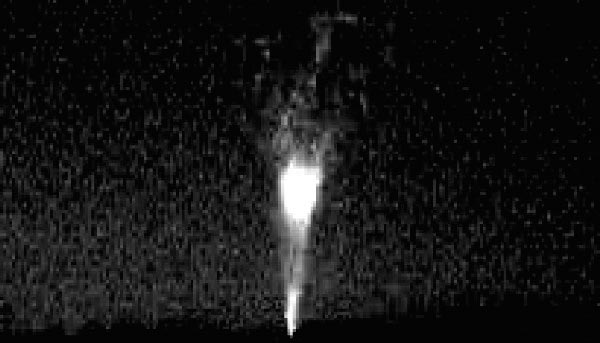Ever since the American polymath Benjamin Franklin braved electric storms with his scientific kites, the study of lightning has been associated with the Romantic explorer in search of scientific answers. The latest Romantics to shed light on this spectacular natural phenomenon are a team of physicists in the US who have managed to capture the most detailed images yet of a “gigantic jet” – a rarely seen form of high-altitude lightning that shoots upwards towards the heavens.
Gigantic jets are believed to initiate from the electric coupling between the lowest part of the atmosphere, known as the troposphere, and the upper atmosphere at altitudes of 90 km where lots of free ions and electrons exist. This form of lightning has been observed previously from the ground and from orbit. But, because it happens so high up in the atmosphere, no one has yet managed to get close enough to study its electric properties during a strike.
Braving the storm
To obtain a more detailed picture of the physics, the team at Duke University, North Carolina and Yucca Ridge Field Station, Colorado, set out to observe a gigantic jet in action during the tropical storm Cristobel in July 2008. To their surprise and good fortune, on 21 July, a gigantic jet struck within just a few kilometres of the researchers’ recording station near Duke University. The researchers established the exact location and dimensions of the bolt using low-light photography, and quantified the transfer of electric charge by observing the lightning’s radio signal using a series of ground-based radio sensors.
Presenting their findings in Nature Geoscience, the team recorded the total charge transfer from the troposphere to the ionosphere as 144 C for the estimated lightning bolt length of 75 km. This is about the same amount of charge that is transferred in strong cloud-to-ground lightning strikes but with the charge being transferred in the opposite direction – away from the Earth towards the upper atmosphere. “Knowing how far the jet was from our sensors, combined with the radio signals, enables us to say how strong the jet current was,” says Steven Cummer, an electrical engineer at Duke University and leader of the research team.
Gigantic jets have been captured on camera previously but in the past they had only been observed from many thousands of kilometres away. “We were lucky to capture on video a gigantic jet so close to our radio sensors and this meant that we could make high precision measurements with very little uncertainty,” Cummer told physicsworld.com.
Unanswered questions
While this research provides the most accurate picture yet of gigantic jets, it does not completely solve the mystery of how this phenomenon is initiated within clouds. “It appears that these gigantic jets are connected to layers that contain a lot of total charge, but really understanding this will require some measurements of the internal structure of lightning channels within the clouds during gigantic jets, which we don’t have yet,” says Cummer.
The researchers intend to develop their research by observing more gigantic jets in more detail. “One thing that we’d like to do is capture a gigantic jet with a higher speed camera that we are now running, in order to resolve in time how they actually develop,” Cummer continues. Documenting more jets would let them get a better idea of what can produce gigantic jets.
Fortunately for air passengers, almost all commercial planes fly below the top of the very tall thunderclouds – up to 15 km altitude – from which these gigantic jets emerge. However, there are a few high altitude aircraft that should take precautions. “Even though gigantic jets appear to be pretty uncommon, they could affect something that was not well protected from lightning,” warned Cummer.




